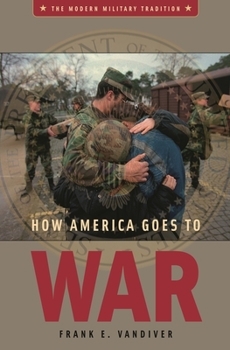How America Goes to War
With American involvement in Iraq in the forefront of national news coverage and in the minds of many citizens, questions concerning America's involvement in past conflicts have once again arisen. This is the story of how the United States has gone to war and how the evolution of the nation's war-making apparatus has mirrored the nation's rise to global power. It focuses on the president's role as commander-in-chief vis-a-vis Congress from George...
Format:Hardcover
Language:English
ISBN:0275985148
ISBN13:9780275985141
Release Date:June 2005
Publisher:Praeger
Length:176 Pages
Weight:0.99 lbs.
Dimensions:0.8" x 6.4" x 9.6"
Customer Reviews
1 rating
A brief, erudite introduction to US military involvement
Published by Thriftbooks.com User , 18 years ago
With the US troops deployed in Afghanistan and Iraq and the American and international community discussing the rationale behind America's involvement in the post-9/11 conflicts, this could not be a more timely publication. This volume clearly draws on a lifetime of writing and expertise gained by Vandiver during his long and accomplished career. The author looks at the relationship between the President and the Congress, from George Washington to George Bush. The book is structured chronologically by conflict. Those analyses are intertwined with short discussions of topics such as the evolution of the army, increasing international military US presence, the Truman Doctrine, and rising technological superiority of the US military. Vandiver finishes off with the most recent US military involvement, i.e. the "war on terror." Throughout its history, America's rise to a global power has been linked with how and when it went to war. In the process, the President's role vis-à-vis Congress has significantly increased. Vandiver's main thesis is that America's future will depend on how it engages in military actions. He is unapologetically critical of this last military pursuit. In his view, George W. Bush "came into office determined to scrap America's wimp image-lingering from his father's and Bill Clinton's hesitant foreign policies-and to finish what amounted to an unfinished family crusade. From the start, he wanted Saddam Hussein gone. The question was, how? Terror brought the answer. (p. 131). Although the author considers, perhaps even accepts, the possibility that "the United States has already sold itself out to the endless maw of militarism" (p. 144), ultimately, his message is not pessimistic. The typically American traits of "optimism, care for the underdog, and a deep-struck love of liberty" combined with a "slowly spreading countrywide alarm about the future" provide hope for "the rise of a mature national conscience". One of the related questions that receives little, if any, attention in the volume is government efforts directed at the general public, both within and outside the United States, efforts referred to as communication and/or propaganda campaigns, aimed at manufacturing consent and gathering support for going to war. To sum up, this brief, 144-page analysis serves as a thoughtful, erudite, and rewarding introduction to questions of U.S. military involvement, national security and the related decision-making process, an analysis that puts the current conflict in perspective. The full version of this review appears in the Spring 2006 issue of "49th Parallel: The Interdisciplinary Journal of North American Studies", University of Birmingham.





